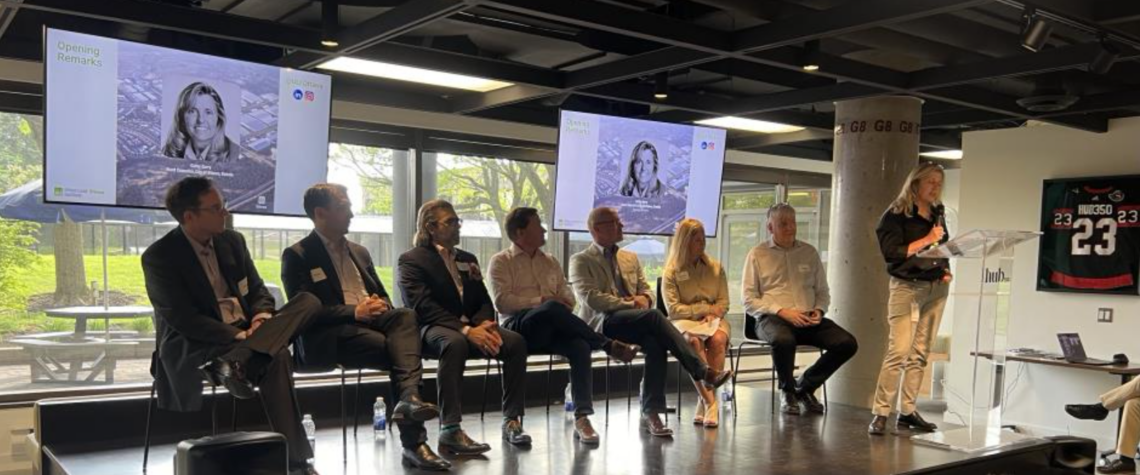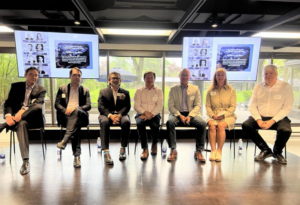
“Here we build things, we build communities, and we look ten, twenty, thirty years down the road.” This quote from Terry Young, Vice President, Operations at KRP Properties, set the tone of the ULI Ottawa event at Hub350, ‘Kanata on the Move’.
The gathering brought together a diverse group of stakeholders, including developers, architects, real estate professionals, and curious citizens, to discuss the future of Kanata North, Canada’s largest technology hub. The panel was moderated by Stephen Willis, Senior Principal of Urban Planning at Stantec and included Nokia’s Andy Thompson, Greg Winters of Novatech, Daniel Byrne from Main + Main, Veronica Farmer of Wesley Clover International, KRP Properties‘ Terry Young, and Guy Levesque of uOttawa and acting Executive Director of the Kanata North Business Association. The event was a resounding success, drawing a full house of highly engaged guests and panelists, many of whom were first-time visitors to KNBA’s Hub350. Attendees ranged from high-level professionals to curious local citizens, all eager to discuss the future of Kanata North.

Ward Councillor Cathy Curry offered opening remarks, reminding the crowd that Kanata North is a goldmine of opportunity. “Starting from one company and growing to 540 is no small feat. The designation as a special economic district is significant. That means we have municipal, provincial, and federal importance,” Curry emphasized. As far as what the future holds, Curry highlighted the expansion plans of key companies like Sanmina, Dell, Syntronic, and Nanometrics and the approval of 8,910 housing units along March Road alone.
Challenges
Energy costs, housing availability, and infrastructure development were a few of the challenges shared throughout the panel.
Andy Thompson noted, “Electricity matters. Why? We spend $10M a year on electricity. You need to have the economics make sense.” Taking a proactive approach, Nokia is now planning a battery bank system to enhance energy resilience and reduce costs, as well as support Hydro Ottawa during service interruptions. A win-win scenario for the city.
“Reducing energy reduces cost and increases competitiveness,” stated Terry Young. KRP Properties is also committed to reducing the carbon footprint of the tech park and finding new ways to share power with neighboring companies. “This building you’re sitting in, although it’s circa ’99,” Terry adds, referencing 350 Legget Drive, “– it’s one of the most energy-efficient buildings in Ottawa. We’ve backboned our system with innovative technology.”

Regarding housing availability, Kanata currently has the fewest vacancies across Greater Ottawa. Although significant efforts are underway to expand housing capacity, from new developments to flexible zoning, Kanata faces a unique scale of demand. As a tech park that attracts global attention, the region expects exponential growth as multinationals (MNEs), Small-Medium Enterprises (SMEs) and start-ups continue to settle here and bring their workforces with them.
“We’re now seeing this area turn from a very heavy industrial park to what is truly an innovation center,” Greg Winters explained, adding that this must include accommodating residential growth. Novatech has started collecting student data to meet their housing needs, ensuring a vibrant, inclusive community.
There have been coordinated efforts across all levels of government regarding the growth of Kanata North, and more are needed to ensure its continued success. In a future of unprecedented growth, Kanata will require infrastructure development to support its ‘live, work, play, learn, innovate’ motto. Increased transportation, recreational spaces, and public services are a few of the needs facing the community.
“Getting things to the top of a pile” is something Winters still identifies as an obstacle. Thankfully, the City of Ottawa is committed to rethinking its planning processes to allow projects to come to fruition in a timely, cost-efficient manner. Bureaucratic hurdles don’t just delay projects, but they are a deterrent to companies who may consider moving to Kanata. “In some cities, it’s difficult to get things done. We don’t want to be that” said Councillor Curry.
Opportunities & Vision
While facing challenges, Kanata North is also brimming with opportunities and driven by its vision of a thriving, sustainable innovation community. From the region’s first dose of economic power, when Terry Matthews founded Mitel amongst the cornfields, to today: vision remains the prevailing force in Kanata North.
Combined efforts from local post-secondary institutions like Carleton University, the University of Ottawa, and Algonquin College with tech giants like Nokia and Nanometrics create experiential learning opportunities and a talent pipeline with unforeseen strength. “It’s like a teaching hospital,” Thompson said of the 550+ coop students at Nokia this year.
Moving towards net-zero carbon emissions and energy resilience is another huge vision for the park. Expanding companies are largely focusing on sustainable, energy-efficient buildings. Safeguarding greenspace is a priority as well, and KRP Properties has a tree inventory system to ensure that Kanata is always ‘growing.’
The panelists were all in support of long-term community building and looking down the road. “It’s not all finance-driven,” said Young. The city is less focused on immediate gains, but rather on how to invest in creating lasting value for the community at large. This event was a prime example of how we can bring together not just Kanata-based champions, but also influential leaders and builders from across the city, to challenge conventional thinking while fostering new ambassadors of economic, social, and community development in the Tech Park.
Kanata North stands at the cusp of a transformative era, with immense opportunities and visionary plans that promise to shape its future. The focus on residential and commercial expansion, infrastructure improvements, and sustainability are key drivers of growth. By creating a holistic “live, work, play, learn” environment and fostering a collaborative, innovative community, Kanata North is poised to become a beacon of technological and economic success in Canada and beyond.
If you want to get involved with the Urban Land Institute’s Ottawa chapter, visit their website.
Thank you to the event sponsors: ULI Ottawa and Carleton University, CU@Kanata.
And to the ULI Ottawa Planning Committee for this event :
– Calvin Tong – Director, Carleton University CU@Kanata
– Benjamin Gianni – Vice Chair, ULI Ottawa, Associate Professor Azrieli School of Architecture and Urbanism, Carleton University
– Eric Bays – Senior Urban Planner, Stantec
– Dina Sarhane – Co-Chair, ULI Ottawa and DSS Architect
– Evan Garfinkel – Co-Chair, ULI Ottawa and Regional Group
– Jamison Young – Treasurer, ULI Ottawa Chapter and Partner BLG
– Cris Persicano – Communications Chair, ULI Ottawa and Minto Group
Written by Hannah Manierka, Kanata North Business Association
